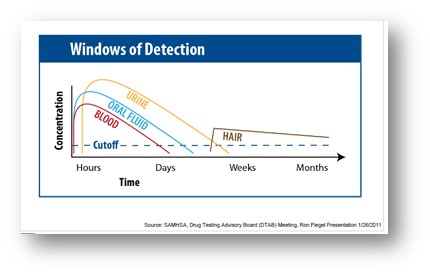Recently I had to tell one of my clients that his “rock star” employee’s drug test came back positive for an illegal substance following a random drug screening. The result had been confirmed using our standard protocol of lab-based urine analysis using a Medical Review Officer (MRO). The client was shocked and dismayed. He also wanted to retest the employee immediately believing the drug test result was an error. His question was simple--Is a blog drug test better than a urine drug test? After all, this was one of his top employees whom he counted on and needed on the job. He simply didn’t believe the positive test result could be accurate in this case.
We ensure that the initial result is correct because we use Substance Abuse and Mental Health Services Administration (SAMHSA) certified labs, using a split specimen collection, so a positive sample can be confirmed for accuracy at another SAMHSA certified lab--as it was in this case. However, our client was adamant that we come out right away and conduct a blood test on the employee to double-check the lab results. His assumption was a blood test would provide the most accurate drug test results. After all, it is invasive and expensive, so he thought it must be the better way to test for and verify the presence of an illegal substance.
Urine test vs. blood tests: finding the truth
Unfortunately, we had to explain the window of detection for illegal drugs is actually shorter in a blood test than compared to other methods like urine or hair. Since a couple of days had already passed since the initial urine test, a blood test wouldn’t necessarily prove his employee hadn’t used the drug. If he was not a habitual user, the drug could have cleared his system within a few days.
This situation illustrates the challenge employers face when a top performer tests positive for an illegal substance in a drug test. If your Houston Drug Free Workplace policies are detailed and properly communicated, they give you a procedure to follow that treats everyone the same way. If your policies are a bit subject to interpretation, you run the risk of finding yourself in a situation where you or a supervisor may choose to treat a higher performing employee differently--leaving your business liable for potential legal issues.
What would you have done in a similar situation based on your current drug testing policies? Do you have all the bases covered? Are protocols in place to keep supervisors from being tempted to make up rules as they go along if a star performer tests positive for an illegal substance in a drug test? This might be a good time to review your Houston area Drug Free Workplace program and look at what, where, when and how you are conducting drug testing. Here are some things to know about four types of drug tests.

1) Oral Fluid testing may be right for your business model, if you are in an office setting in Houston, and employees are not subject to Department of Transportation (DOT) regulation. While we specialize in DOT compliance, we do use Oral Fluid Testing for clients with safety-sensitive positions who are not under those mandates and for clients in office settings. It gives you a quick and easy option. Employees won’t spend hours out of the office going to and from a lab, nor will they have a chance to adulterate a sample. These saliva drug tests have come a long way and will still be lab-verified. They can indicate whether someone has used an illegal substance within the previous 24-48 hours, so recent use or impairment is likely to be identified this way.
2) Blood tests are also a better indicator of recent substance abuse. They may be used in an accident case where a DUI is suspected to test for proof of impairment at the time of the incident, but they are difficult to administer, invasive and expensive. There is no reason to use them in routine workplace drug testing.
3) Hair tests will not give you a measure of recent, new use as it might take seven to 10 days for residue from a substance to be measurable in this way, but it could be the key to identifying a long-term, habitual user. They are controversial because an illegal substance taken months prior could show up in this kind of drug testing, while someone who is actually impaired may not test positive if they had no prior history of using the substance. Which brings us back to where we started.
4) Urine tests. An illegal substance will show up in this drug test anywhere from a few hours to seven days after its use. In the case of marijuana, for example, even a one-time use could be caught with this test. Chemical residues from longer term use can be present in urine up to 90 days after the last drug use. This is the preferred drug testing method for most of our clients.
Does your Houston business conduct drug testing? What method do you think is right for your business model and why?

.png?width=500&height=500&name=Blue%20and%20White%20Classic%20Shield%20Financial%20with%20Star%20Logo%20Design%20(1).png)


